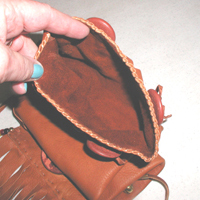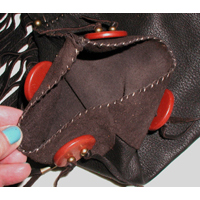Lakota Catlinite Medicine Wheel Pipe Bags | ||||
 Tan - suede outside smooth inside 
|  Amber - smooth outside suede inside
|  Brown - smooth outside suede inside
|  Saddle - suede outside smooth inside
| |
|
| Alan
Monroe, Lakota $395 plus s/h "An Authenticity card from the artist is available upon request. Just add a note in the box on the order form." | ||||
| ||||||
The solid pipestone buttons are for decoration. Buttons are 1 1/2" diameter x 1/4" thick
Back is plain with no medicine wheel. Beads of Four Sacred Colors on the bottom corners. The long lace ties attached towards the top of the bag are wrapped around the bag and stem and tied. | ||||||
About Pipe Bags Alan Monroe's open top pipe bags are based on the traditional Plains Indian design. They are made of thick and supple deer leather to protect the pipe and stem and other objects you might carry inside such as a tobacco bag, pick, and tamper. Each bag is hand cut and hand stitched. The sacred pipestone (catlinite) is from Alan Monroe's personal quarry at the National Monument and Shrine located in Pipestone, Minnesota. There is a pipestone medicine wheel on one side only so the bag can be laid down on the plain side. The solid pipestone buttons are for decoration. Alan leaves the bottom panels and fringe plain so you can decorate them with painting or beads to personalize the bag. Traditionally, the pipe bowl is wrapped in cloth or leather and placed the bottom of the bag. The stem is either wrapped or not and placed in the bag. A stem longer than sixteen inches will protrude from the top of the bag. The long laces are wrapped around the bag and tied. The laces can be left long or cut off as desired. The bag is carried by holding at the tied area. The bag and contents can be stored in a drawer or hung by the tied laces. |
|
Alan Monroe - Oglala Lakota Alan Monroe creates his Northern Plains artwork from hides, stone, leather, and wood. He learned the basics of quill working, weaponry, sculpting and pipe making from traditional and contemporary artisans in his family circle. He is a fifth generation pipe maker and considered by many to be a master pipe maker. In his sculptures, Monroe works with a variety of materials such as pipestone, bone, wood and alabaster. He creates small objects like fetishes to large pieces than can weigh hundreds of pounds. Al Monroe's work can be seen in many galleries and museums across the country and he has won many awards. Al Monroe was born in Hot Springs , South Dakota and is an enrolled member of the Oglala Sioux Tribe. He graduated from Hot Springs High School and studied business and art in Nebraska, Tennessee, and South Dakota. | ||
PipestonePipestone, also known as catlinite, is a form of clay called argillite with a high iron content that colors it a deep red to pale orange. Pipestone was discovered in southwestern Minnesota by the Sioux Indians, who consider it a sacred material and use it to carve pipes and other ceremonial objects. It is easy to carve because of its lack of quartz. Read about stones |
The Medicine Wheel, or Circle of Life, is found in many tribes and in many parts of the world, but there are beliefs common to them all. The compass points North, South, East and West give four directions. Mother Earth is below and Father Sky is above, giving six directions. These six directions are also symbolized by animal fetish carvings. The circle shape represents life. We change like the seasons as we pass through life, traveling through the part of the circle. The center of the circle is the Spirit, from which everything extends and everything returns. Below are some general beliefs about the colors, animal totems and uses of the medicine wheel. Every tribe and every person has their own beliefs and you should use what best represents what you believe.
| |||
| "I received my Alan Monroe bag yesterday and I'm very pleased with it. Thank you very much." - MR |